|
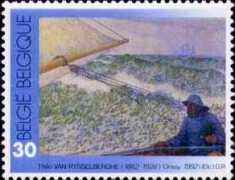
|
Maritime Topics On Stamps :
Circumnavigators !
|
|
This page depicts stamps of circumnavigations of the world with small
boats, yachts and cutters. But we will take a look at the very first round-
the-world trip, as well.
| |
On the 20th of September, 1519, Spain's Magellan started his voyage
with a fleet of five small ships and 273 crew members. His goal was to
find a new way to the spice islands, the Molukken, other than the
Portugal-controlled route round the Cape of Good Hope.
On this journey he discovered a passage to the Pacific in South
America, which became known as the Magellan Strait.
All-in-all it was a catastrophic voyage. Many sailors died by
expiration and hunger. Ships were lost in heavy seas and
captured by pirates. Magellan himself was murdered by natives on the
Phillipine Islands.
|
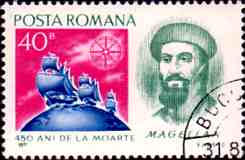
| |
After three years, the last vessel, the 'Victoria' entered the port of
Sevilla under the command of Sebastian del Cano and only 18
survivors. The first circumnavigation of the world was completed!
|
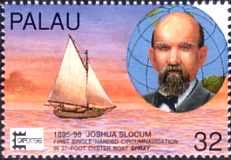
|
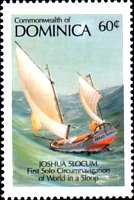
|
|
The American Joshua Slocum worked many years as a captain on cargo
sailing ships. At the age of 51 he wanted to do something that nobody
had done before:
to sail a boat around the world on his own. On the 24th of April 1894
he started with his 'Spray' - a wooden boat, length 37ft, two masts,
sloop rig, no motor and no auto pilot!
He sailed from Boston to Spain, then changed the course to South
America and entered the Pacific through the Magellan Strait. On Slocum
went via Samoa to Australia, South Africa, Barbados and back to
Newport in the United States, where he arrived on the 27th of June,
1898. He travelled approximately 45,000 nautical miles. The first
single-handed cicrcumnavigation of the world was completed.
|
|
The French Alain Gerbault started out as an engineer, became an
aircraft pilot during World War One, changed to business man
afterwards and all the way was an excellent tennis player. His
restless spirit drove him to more and more exceptional activities and
so he simply chose to became a sailor.
In April 1923 Gerbault left the port of Cannes with his boat
'Firecrest'. It was made of wood, had a length of 39ft, was rigged as
a cutter and 32 years old. During the voyage to New York he was washed
over board by heavy sea, but managed to climb back. Passing the Panama
Canal Gerbault reached the Pacific Ocean and sailed from one island to
the other.
Two times he ran ashore on a reef, once even with the loss of his
keel, but he quickly found help everywhere. In July 1929, after six
years Gerbault arrived back in France. After receiving the honours he
built a new boat and sailed back to the South Sea.
| 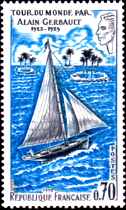
|
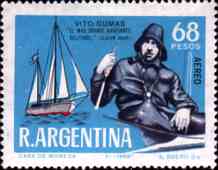
|
From June 1942 to July 1943 the Argentinian Vito Dumas sailed single-
handed around the world. His route was bound eastward from Buenos
Aires via Cape Town to New Zealand, then across the Pacific Ocean to
Chile. Dumas took honours for rounding Cape Horn as the very first
'yacht man' and safely made it back to Argentina. His wooden boat, the
'Legh II', had a length of 33ft and a Ketch rig.
Dumas worked in the cattle business, but was a member of a sailing
club, where he learned sailing.
During his circumnavigation he had to fight several leakages and an
infection in his arm, which temporarily caused very high fever.
| |
In the 'Roaring Forties' his boat was rolling in waves up to 50 feet high,
and he had several 'near collisions' with passing whales. Off Cape
Horn a high sea threw Dumas off his feet and broke his nose. Back home
he was welcomed as hero and received awards by the dozens.
|
|
The yacht on this Uruguayan stamp was build in 1933 as 'Microcosmos'
at Amsterdam. Later on she was bought by four Uruguayan navy officers
for a journey around the world and renamed to 'Acherra'.
During their preperations one of them died, causing them to rename the
boat once again. From now on she bore the name of the deceased
comrade, 'Alferez Campora'. Nonetheless the three officers
Nader, Costa and Firpo managed to circumnavigate the world with
this ketch from 1960 to 1963.
|
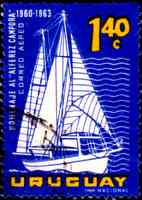
|
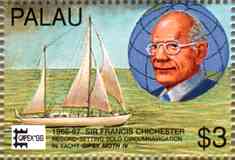
|
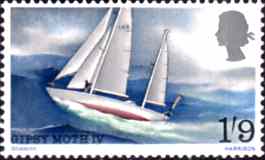
|
|
In 1963 the English Francis Chichester won the first 'Observer'
single hand Trans-Atlantic race.
After a long and varied life between England and New Zealand he
decided to circumnavigate the world using the route of the Australian
Clippers of old.
After three prototypes Chichester built his 'Gipsy Moth IV', length
53ft, two masts, yawl rig, 11.5 tons displacement.
Starting on the 27th of August, 1966, he sailed single-handedly and
nonstop from Plymouth via the Cape Agulhas to Sydney in 107 days.
After some repairs Chichester went on, again nonstop, via the Pacific,
Cape Horn back to England. He needed a total of 274 days and during
the 226 days on sea he reached an average speed of 4.5 knots.
Chichester was 66 years old and was knighted shortly thereafter.
|
|
In 1968 the Englishman Robin Knox-Johnson took part in the Sunday
Times Golden Globe solo round-the-world race. He was the one and only
out of ten participants, who reached the destination Falmouth after a
struggle lasting 313 days. His 33ft wooden boat 'Suhaili' was rigged
as a ketch. Inside Tairoa Heads, Otago/NZ Knox-Johnson ran aground, but he
was able to free himself and his boat. Over the whole distance of
30,123 nm he sailed with an average speed of 4,02 knots. Nevertheless,
he was not the first man sailing alone nonstop around the world.
|

| |
The French Bernard Moitessier, who took part in the same race and was
leading the fleet far in front, had already crossed his outbound
course and so finished a circumnavigation. But then for some
unintelligible , inconceivable reason Moitessier changed his course
and headed on eastward to finish a second circumnavigation. He became
the first solo nonstop circumnavigator but of course was immediately
disqualified regarding the Golden Globe race.
|
The loneliness, the daily fight with the sea, the lack of sleep, fear,
illness and injuries change the human beings in their small boats.
Many solo sailors made the experience, that suddenly other thoughts
and things became more and more important. They became aware how their
surrounding and way of life was changing them. We know of one sailor,
who even completely lost his mind (people later found his empty boat
with his logbook).
|
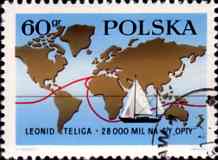
|
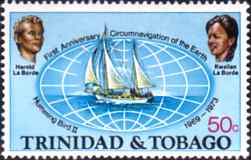
|
While growing up the Polish Leonid Teliga read all the books about
Slocum and Gerbault. His dream, to be like his heroes and to
circumnavigate the world on his own, became true from 1966 to 1969.
(see stamp to the left).
Teliga's wooden boat 'Opty', an abbreviation for 'optimism', had a
length of 32.4ft and was rigged as a yawl. He started at Casablanca,
Morocco, because he didn't got the permission to go through the Baltic
Sea during winter time. Teliga sailed on westward via the Panama
Canal into the Pacififc Ocean. One time the sailing beam crashed into
his stomach, causing constant pain for the rest of the yourney.
On the right stamp you can see Trinidads Haraold La Borde and his wife
Kwailan.
In 1960 they crossed the Atlantic Ocean with their 'Hummingbird I',
and from 1969 to 1973 they circumnavigated the globe with their
'Hummingbird II'. She was a 40ft boat, rigged as a ketch.
From 1984 to 1986 they sailed around the world once more.
|
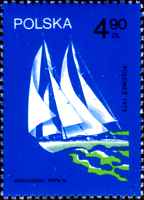
|
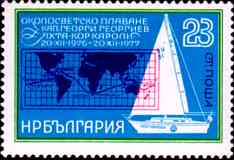
|
On the stamp to the left you can see the 46ft ketch 'Polonez'. In 1972
the Polish Krystof Baronowsky took part in a Trans-Atlantic race and
finished twelfth. Afterwards he sailed around the world eastward with
the same boat in two years. It took him only 45 days from
Hobart/Tasmania to Cape Horn, setting a new record for solo sailors.
On the stamp to the rigth you can see the 'Kor Karoli', the boat of
the first Bulgarian circumnavigator Georgei Georgiov.
He sailed with this boat single handedly around the world from the
20th of December, 1976 to the 20th of December 1977. On this stamp his
course via the Panama Canal is depicted.
|
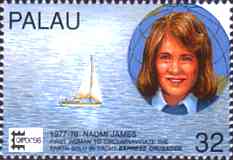
|
From March 1976 to April 1978 the Polish woman Krystyna Chojnoswka-Liskiewicz
sailed alone from Las Palmas westward via the Panama Canal
around the world. Her boat was the 30 feet 'Mazurek'. She was a
shipbuilding engineer and driven by the ambition to become the first
woman to complete a solo circumnavigation.
New Zealand's Naomi
James did a single hand circumnavigation from September 1977 to June
1978. With her 53ft fiberglass yacht 'Express Crusader'
she even managed to beat the old record of Sir Francis Chichester by
two days. She circled the globe eastward in 272 days.
| |
In some newspapers, books, on the stamp to the left and on the
cover of Naomi's own book anyone could read that she was the first
woman sailing alone around the world. In fact Krystyna was the
first and Naomi the faster one, but both of them were brave and
excellent sailors!
|
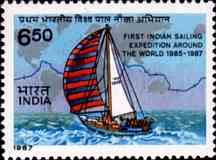
| 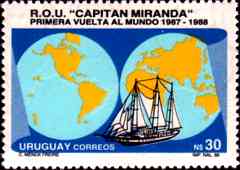
|
|
In the eighties, circumnavigation became fashionable. To the left you
can see the 'Trishna' of the Indian Navy.
From 1985 to 1987 she was on a circumnavigation westward via the
Panama Canal, (the course is depicted on the stamp). To the right you
can see the three-masted schooner 'Capitan Miranda' of Uruguay. This
ship was build in 1930 and sailed around the world from 1987 to 88.
Today many boats sail around the world every year. Most of them are
married couples fulfilling themselves the old dream of a
circumnavigation. Then there are sport sailors, who want to win races
and/or break records.
But there are people, who simply want to break free from 'normal'
life, as well.
|

|
In 1994 Britains Robin Knox-Johnson and New Zealands Peter Blake tried
to break the world record for the fastest circumnavigation. Using the
92ft catamaran 'ENZA NZ' it took only 74 days and 22 hours to complete
the 26,414 nm. In the beginning the cat ran with an average
speed of 20 knots but a few windless days decreased the speed to 14.7
kn. With only a few days before arrival, an extremely dangerous
situation arose.
| |
A heavy storm threatened to capsize the boat and the
the crew had to stabilise it by towing a heavy chain throw the water.
This record trip was honoured with the Jules Verne Trophy.
|
|
Like Moitessier and Tabarly, Olivier de Kersauson was one of the great
French yachtsmen. In 1988/89 he set a new world record for
single hand circumnavigation with his trimaran 'Un Autre Regard'. In
125 days he sailed 29,150 nm around the world. In 1993/94 Kersauson
needed only 77 days with the 'Lyonnaise-des-Eaux-Dumez'. In 1997 he
cut the record to 71 days and 14 hours with the 89ft trimaran 'Sport
Elec', which got him the Jules Verne Trophy (this time he had a crew
aboard though). In 2001 Kersauson built a 109 feet trimaran 'Geronimo'
and as of today, plans a new record breaking trip in 2002.
| 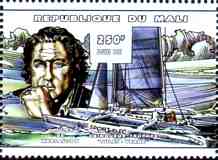
|
This, because in 2001 a new record was set by Grant Dalton with his
112ft trimaran 'Club Med'. He started in Barcelona and finished at
Marseille after a circumnavigation of 23.800 nm within 62 days and
seven hours, averaging 16 knots. Currently, in 2002, the trimaran
'Orange' is surfing around the world with up to 37,8 knots.
|
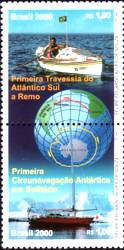
|
On the double stamp above you can see a rowing boat crossing the South
Atlantic. The second stamp depicts the sailing boat 'Paratii' to
remember the first circumnavigation of the Antarctic. Both record-
setting voyages were done by the Brazilian Amyr Klink. You can see
their courses on the globe depicted on the stamps.
In November 1998 Klink started from Southern Georgia. His 'Paratii'
was a 50ft aluminium boat with a new light-weight 'Aero Rig System'.
Klink was back after 88 days, 20 days earlier than he had calculated.
He reported thick fog, heavy gales, 45ft high waves, icebergs, surf
speed of up to 14 knots, frozen oil in his cooker and the constant
noise of sea-elephants.
|
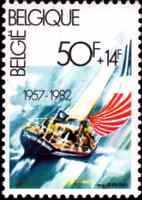
|
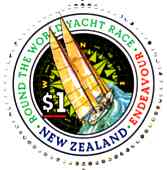
|
Today we have three 'Round-the-World-Races' which will repeat in
different periods.
- The 'Whitbread Round the World Race' - a race divided into
several legs. The first race started 1973/74, returning in four year
intervals up to 2001/2. For the last race the main sponsor changed and
the race was renamed to 'Volvo Ocean Race'. On the stamp to the left
you can see the yacht of the European Union (EU), the 'Traite de
Rome'. She took part in the races in 1977/78 and 1981/82.
To the right New Zealand's 'Endeavour', winner of the 1993/94 race.
- The 'Vendee Globe Challenge' is a 'Solo Nonstop Round The
World Race'. Introduced in 1989 this race is repeated every four years
as well. This race is more about rounding the Antarctic (see the
course on the stamp below), but remains an extremely diffcult single
hand race fighting the grim coldness and the constant threat of
dangerous icebergs; one sailor never returned.
- The 'BOC Challenge', later on called 'Around Alone', is a
race consisting of several legs. The first race started 1982 and like
the others repeats every four years. (BOC is the abbreviation of the
first sponsor, British Oxygen Company.)
|
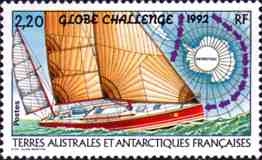
|
The actual distances travelled vary depending on the course of the
circumnavigation. On a course along one of the Pole's one can pass
all longitudes in a very short time. The circumference at the
equator is 40.075km, i.e. 21.639nm, but nobody can sail straight along
the equator without hitting land mass. We are speaking of a real
circumnavigation when you pass both antipodes of a 'great circle',
that means you have to pass the points directly opposite on both sides
of the world.
| |
The favourite route around the world follows the three
capes. One sails eastward round Cape Agulhas, South Africa, continues
to Cape Leeuwin in Southeast Australia and finally the famous Cape
Horn at the southern tip of South America. This was the historic route
of the Australian Clippers where one could exspect the best aft winds.
|
The first German single hand circumnavigators were Alfred Kallies
with his 'Pru' (1965/69) and Wilfried Erdmann with his 'Kathena'
(1966/68). Erdmann again was the first German to circumnavigate the
world eastward alone nonstop (1984/85). In 2000 he started again, aged
61, on a single hand nonstop westward bound voyage against the main
wind and stream directions. Among many excellent German sailors
Erdmann is probably the greatest.
On the stamp to the right you can see the German racer
'illbruck'. This is the first German boat ever won a race round the
world (2001/02).
|
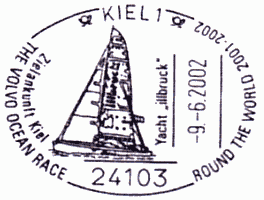
|
|